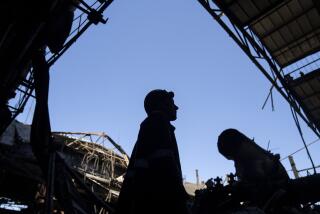Reluctant Ukraine to Shut Last Reactor at Chernobyl
CHERNOBYL, Ukraine — In the first days of the 1986 nuclear disaster here, when Chernobyl’s toxic plume of radioactive debris had not yet been reported in the West, Pyotr Zborovsky was in the thick of it. He used a sledgehammer to break into the reactor building and climbed down in darkness until his tarpaulin boots were immersed in radiation-contaminated water.
Disregarding the danger, for several days the then-army captain led a unit that desperately pumped irradiated waste water out of the building and into a containment pond before it could poison the water supply of Kiev, the capital of Ukraine.
Sitting 14 years later in his two-room apartment in Kiev with his wife and his dog Fluff, looking at the yellowing newspaper clippings about his heroism, Zborovsky assessed the costs. Among his 65 men, he said, six or seven have died, most before the age of 40.
Zborovsky himself has never been the same. He passes out frequently, and his bones are brittle. The 48-year-old, once called Moose for his strength, has had three fractures in the past 18 months.
Yet despite his experience during the world’s worst accident at a nuclear power plant, he shares a feeling widespread among fellow Ukrainians: He opposes the planned closure Friday of the last operating Chernobyl reactor.
“Now is not the time,” he said, reflecting on the expected loss of thousands of jobs and about 5% of the nation’s inadequate supply of electricity. “The economy of the country is not that strong.”
Defying overwhelming public sentiment at home, Ukrainian President Leonid D. Kuchma plans Friday to issue the order switching off reactor No. 3 here, making good on a pledge he gave to Western leaders five years ago. The plant, which was closed for technical reasons last week, was powered up again this week for the event.
“We would like to be ushered into the 21st century with a closed Chernobyl nuclear power plant and not an open one,” explained Ecology Ministry spokesman Sergei N. Peleshenko.
Need for Western Aid Is Said to Be a Factor
Critics say it is Ukraine’s need for Western investment and loans, and not concern about safety, that drives Kuchma’s decision.
Otherwise, they ask, why close a plant that has been operating without incident within international guidelines and that only recently underwent $300 million in safety improvements--especially when its replacement has not yet been built? And why during winter, when power demands are at their height? Already, many rural areas go without electricity for six hours a day.
It is easy to see why Ukraine needs Western help. For Chernobyl alone, the country requires $758 million to build a new sarcophagus around the destroyed reactor to hold in deadly radiation; the shell constructed after the accident is leaking and unstable.
Ukraine also wants the West’s help to finish construction of two new nuclear reactors to compensate for the energy lost by the shutdown of reactor No. 3 and the earlier closures, under Western pressure, of Nos. 1 and 2. The European Bank for Reconstruction and Development approved an initial $215-million loan for the $1.5-billion project last week--conditioned on Chernobyl being finally shut down.
That is why Kuchma is expected to use the shutdown to win more help for his struggling country. The prime ministers of Russia and Belarus, along with Kuchma and U.S. Energy Secretary Bill Richardson, are expected to make a one-day visit to the site today. And for Friday, plant managers are trying to figure out how to get hundreds of reporters and cameras into No. 3’s cramped control room, where the reactor is viewable via a grainy closed-circuit TV.
But for the control room staff--nuclear power professionals who receive relatively high wages and see their careers and families’ future at risk--the attitude is more like: Spare me.
“This is a misfortune that could have befallen anyone,” answered shift supervisor Vladimir Zaytsev when asked how he felt about being put on duty for the shutdown.
Chernobyl is about a two-hour drive north of Kiev, on a road that takes visitors across flat farmland and forest, through villages where roadside cottages are often leaning and in need of paint.
The last part of the journey traverses the nearly empty exclusion zone, which stretches out 19 miles in all directions from the plant. It was from here that 116,000 people were permanently evacuated in the first days of the accident.
Among the communities abandoned was Pripyat, home to nearly 50,000 people who lived within sight of the cooling tower and the four reactors. Now it is a ghost city, overrun with brambles and grass, its communist-era insignia rusting and its debris-strewn apartment buildings starting to crumble from the elements.
Looking at Pripyat, it is easy to imagine that in another generation it will be overwhelmed by the encroaching vegetation and forest. Only a radiation detector gives hint of any danger here, showing higher-than-normal levels concentrated in the mosses that grow in cracking pavement.
After the accident--in which an operational experiment caused the reactor to overheat, prompting fire and an explosion that exposed the core to the outside air--there were fears that the zone would become a nuclear desert for centuries.
Instead, nature has proved resilient. The retreat of people meant that animals and plants could flourish, with growing populations of moose and roe deer, the wolves that feed on them, and wild boar, among others. Poachers are frequent visitors, and the game they kill probably ends up on plates across Ukraine.
Biologists have been trapping mice and voles looking for signs of mutations, but so far the evidence is ambiguous. Botanists, however, note that many pine trees show abnormalities in the structure and number of their branches and needles, suggesting some subtle changes on the genetic level.
At Least 500 ‘Resettlers’ Have Returned to Area
Human life in the zone also has come back, to a modest degree. Aside from the thousands who commute every day to work at the plant or its support facilities, at least 500 “resettlers” have returned despite official injunctions.
“We are like guinea pigs who have lived here for 14 years, and nothing has happened to us,” said Anastasia Chikalovets. “We don’t believe that there is anything there.”
The resettlers are mainly elderly people used to a rural existence who could not manage on their tiny pensions in the city. In the country, with only a few animals and a garden, they can produce most of their daily food.
While feeding visitors pickled mushrooms, bread, fish, cottage cheese and fried pork fat, washed down with potent chlebny moonshine--all products grown or collected in her village of Opachichi inside the zone--Chikalovets and her husband, Nikolai, explained that when they returned a year after the accident they had to hide from officials trying to drive them out.
Then, around 1991, the police let them be. Now they even get free electricity from the Chernobyl plant and occasionally a few food staples from the government.
Although she has visited the nearby plant only once, Chikalovets is worried about what its shutdown will mean for her. “There will be disorder here, and we will be forgotten,” she said.
But the shutdown of the reactor doesn’t mean the immediate closure of the plant, insisted Andrei Shatsman, deputy chief engineer for operation.
“No one is closing the station,” he said. “It will continue to operate for several years to come. The only difference is that from Dec. 15, the people there will be busy with the process of phasing it out.”
As Shatsman explained, the unspent nuclear fuel within the reactor will have to be guarded, removed and put into storage, work that will last at least until 2008. (The existing storage is full, and a European-funded project to build a new site has just begun.)
Although labor unions at the plant oppose the shutdown, arguing that 2,000 of the 9,000 workers will be laid off almost immediately, Shatsman said there will be no sharp reductions, only a gradual shrinkage by attrition.
While no one feels joy over Kuchma’s decision, Shatsman said, “we are not delicate damsels. There is a government resolution, and our job is to carry it out.”
Of course, looming over all of this are the still unresolved dangers of the damaged reactor No. 4.
A plan is in place for reconstructing the sarcophagus. But the long-range problem is how to remove and neutralize the danger of the more than 150 tons of highly radioactive plutonium inside.
Although portions of the interior are accessible and monitored, the fuel within remains deadly. Much of the removal work will have to be done by robots whose electronics will have to be shrouded from the effects of radiation. Peleshenko, the Ecology Ministry spokesman, said the cleanup might take 100 years.
And what of the lasting health consequences of the Chernobyl explosion? Aside from the at least 31 staff members and firemen who died during or just after the accident, there probably have been at least 6,000 premature deaths among the 600,000 soldiers and volunteers who took part in the cleanup, concluded David R. Marples, a University of Alberta historian and expert on the accident.
In studies, researchers have noted a general rise in morbidity, signs of impaired immune responses and various circulatory and skin problems, Marples wrote in the Bulletin of the Atomic Scientists on the 10th anniversary of the April 26, 1986, disaster.
A Sharp Increase in Thyroid Cancer Cases
But the accident’s most concrete health effect has been the sharp rise in juvenile thyroid cancer in areas of Belarus, Ukraine and Russia that received the highest contamination, said Valery P. Tereshchenko, deputy director of the Institute for Endocrinology and Metabolism at the Ukrainian Academy of Sciences.
He said that doctors in Ukraine already have operated on 1,610 young people for thyroid cancer, a figure expected to reach 2,000 in less than five years. The rate of thyroid cancer among the nation’s children is at least 10 times the world average.
And it is anyone’s guess whether cases of leukemia or other forms of cancer will rise in the future, or if a positive link will be established between birth defects and the radiation exposure, as many distressed parents now assume.
However, even if the worst proves to be true, it is clear that Chernobyl still will be missed by many loyalists.
“In the heads of ordinary Americans, the news of the closure will be greeted with relief. But the thoughts of an ordinary Ukrainian will be something quite different,” said Sergei Pavlovsky, the Chernobyl plant’s chief spokesman, who was born and grew up in Chernobyl, worked at the plant and still longs for his old home in Pripyat. “What you are about to see is a very poor country making a very costly present to the world.”
*
Daniszewski was recently on assignment in Ukraine.
More to Read
Sign up for Essential California
The most important California stories and recommendations in your inbox every morning.
You may occasionally receive promotional content from the Los Angeles Times.










